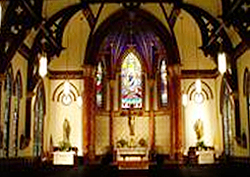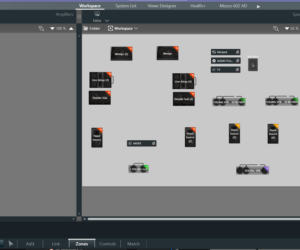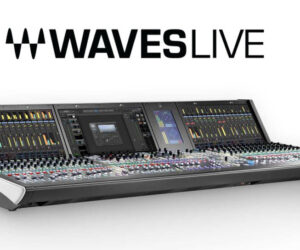In summing up his choice of Tannoy QFlex as a solution for Austin’s Saint Mary Cathedral, Ken Dickensheets is extremely concise. “It’s easy to set up, remains stable and has very high quality sound.”
Sometimes, it really is that simple.
Dickensheets has been working in pro audio for over 40 years, 35 of them in Austin, TX. As principal design consultant at Dickensheets Design Associates, he places a high value on providing the right solution for all his clients, whether those solutions are for public buildings, educational facilities, corporate applications, theatres, or a house of worship install. Doing so, however, extends beyond designing those solutions. It includes an ongoing commitment to meeting the needs of his clients long-term.
That was particularly important in this case, where the pre-existing arrays Austin’s Saint Mary Cathedral had been using were no longer considered adequate.
“Let me give you a brief history,” Dickensheets says. “Saint Mary is a very old cathedral and the seat of the Austin diocese. In 2004 we worked with them during a restoration of the cathedral and, at that time, put in several ‘Brand X’ line arrays.” While the products worked reasonably well at the time, over the years they became increasingly unreliable. “They kept failing, so finally the client said, ‘what can we do about this?’”
Dickensheets’ response was as concise as his earlier assessment of QFlex. “I said ‘let’s just replace the line arrays with something that’s quality, that works. We arranged to have a couple of QFlex 24s brought in for them to try, demoed them in the church and they wouldn’t give them back.”
In its own way, the sheer beauty of the design of Saint Mary Cathedral also reflects the distinct culture of the city and the landscape it inhabits. “It’s a gorgeous room with a very Central Texas motif,” Dickensheets says. “It’s pretty spectacular.”
The cathedral’s origins date back to the mid 1800s, to a small stone church named St. Patrick’s located at the intersection of 9th and Brazos streets. Although the church was renamed St. Mary’s in 1866, it wasn’t until six years later, after the railway arrived and Austin became the permanent state capital, that the parish decided to construct a larger facility to serve the city’s growing population.
Early on, Saint Mary Cathedral was a part of the diocese of Galveston and still designated as a church, the first commission designed by Nicholas Clayton, who would later become one of Texas’ foremost Victorian architects. In 1948, when the diocese of Austin was created, a comprehensive update of the church was undertaken, many of the neo-gothic decorations replaced, and the church was re-designated a cathedral.
The cathedral now occupies a location one block north of the original site of St. Patrick’s and is the heart of a diocese made up of 125 parish churches/communities, and in excess of 450,000 parishioners.
Saint Mary’s design tends to evoke the spirit of the divine using natural settings; tree-like columns, for example, murals covered in a tracery of vines and leaves and a soaring dome dotted with stars to reflect the heavens above. Over time, other details have been included to speak specifically to the cathedral’s place as the heart of a diocese in the heart of Texas – most notably in the case of the cathedral’s baldacchino, which is decorated with cacti and bluebonnets.
According to his company’s desire to deliver solutions that are ‘loud and clear’, when revisiting the system Dickensheets wanted to provide a fix that was sonically superior to the pre-existing loudspeakers, but without adversely impacting the cathedral’s unique atmosphere and décor. “Aesthetically, they had to blend into the church. The QFlex are actually adjacent to some architectural columns so they don’t look out of place at all; they’re very unobtrusive.
“Empirically it was agreed by everyone involved in the project that the QFlex actually delivered higher speech intelligibility and a more natural sound than the more expensive arrays that they replaced,” Dickensheets says.
Tracy Frederick, technician and project manager for Austin Audio and Video, the installers on the project, agrees. “They demoed the QFlex and they never came out again. It was definitely an improvement.” Like Dickensheets, Frederick is a long time resident of Austin, who first moved to the city from Louisiana to be a part of Austin’s burgeoning music scene and has worked at Saint Mary, and with Dickensheets, previously.




















